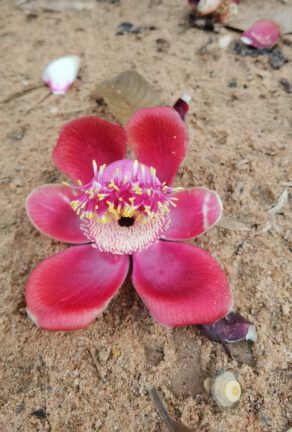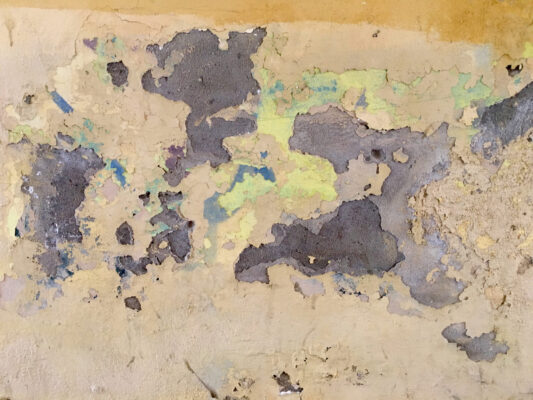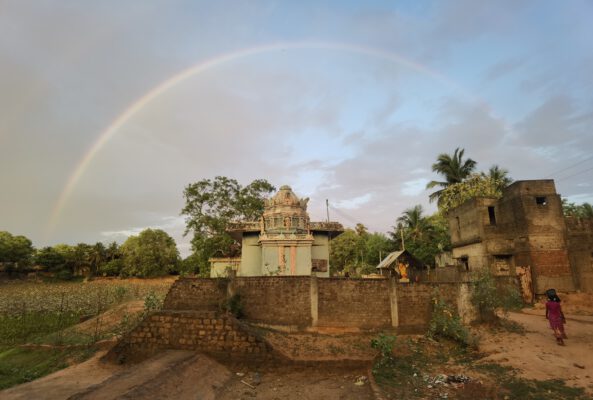Vconnection
Dn the last two years I have immersed myself quite deeply in the Upanishads, practiced a bit of yoga and got to grips with the System of the Yoga a little. I immersed myself in my own body, my own senses, my own consciousness. I have seen that there are a large number of levels and that there is no reason to assume that there are not even more levels. Two years ago, I had simply denied most of what I was experiencing here. It's nice to know that. The world is much bigger than I always thought, it is much more complex, more colorful, more alive, deeper. And that seems to be just the beginning.
A core idea of the teachings in India is letting go, not wanting to have everything and to desire or rejecttolean back. Simply accepting the world as it is is the great art. Simply enjoying it as it is, even if it is not easy, is bliss. Sinking into meditation and being one with the world. This feeling can also be taken from meditation into everyday life, because we all have to eat.
The basic structureüis indeed something
The exploration of one's own body, one's own consciousness, one's own life energy is systematized in the 24 tattwas. The self, its relationship to Purusha (soul), Prakriti (primal nature), the Buddhi (intellect), the Ahamkara (ego consciousness), Manas (sense-bound thinking) connects the essential cognitive and spiritual levels of experience. However, it remains an experience that stands on its own; it seeks unity with the cosmos, transcends itself beyond itself, yet remains in the same existence. Dvaita-advaita, the duality of duality and non-duality, i.e. a complex idea of immanence, which is supported by pure consciousness, its basis is Brahman, that which we cannot really think, but which is somehow accessible in spiritual experience, even if none of our organs are equipped for it. Only in the synthesis of the senses, in the complex experience of pure (disinterested) enjoyment, the sharpening of the senses, lies a path that is rocky.
The Beautiful in India, however, is that it goes on and on. Having arrived somewhere, the little mind imagines that it has grasped something and can put it into words. But here, almost as if in a dialectical reversal, new levels open up.
Before the 24 tattwas come the 12 tantra tattwas. 5 pure (Śiva: pure consciousness, absolute; Śakti: dynamic energy, power; Sadākhya: ever-present, eternal; Iśvara: supreme lord, ruler; Śuddha Vidyā: pure knowledge, clarity) and 7 semi-clean Tattwas (Māyā: illusion, cosmic veil; Kāla: time, temporal flow; Vidyā: limited knowledge, consciousness; Rāga: attachment, desire, passion; Niyati: cosmic order, destiny; Kalā: creative skill, art; Purusha: individual soul, self), which complement the 24 impure Tattwas. The 24 tattwas comprise the 4 Antahkarana (inner instruments)manas (mind), buddhi (intellect), ahamkara (ego) and chitta (memory or consciousness); the 5 Sensory organs (jñānendriya): ghrāna (nose) for smell, rasana (tongue) for taste, caksus (eye) for sight, tvāk (skin) for touch, śrotra (ear) for hearing; the 5 Organs of action (karmendriya): pāyu (anus) for excretion, upasthā (sexual organ) for procreation and sexual pleasure, pāda (leg) for locomotion, pāni (hand) for grasping and touching, vāk (mouth) for speech; the 5 subtle elements (tanmātra): gandha (smell), rasa (taste), rūpa (form), sparśa (touch), śabda (sound); the 5 rough elements (mahābhuta): prthvi (earth), jala (water), tejas (fire), vāyu (air) and ākāśa (ether or space).
The fascinating thing is that the realization that the world as it presents itself to me in everyday life does not exist (everyone here always says that space and time do not exist) is described with Maya. The world exists, if at all, as will and imagination (Schopenhauer). So when I have recognized this and realize that I aover af I still seem to exist somehow, because after all that is what I am thinking, then there must be another way of seeing the world; the world must be different from what I think, there are possibilities in this world that are different from the ones I know.
I have already come to terms with the fact that time, knowledge, causality, my own existence are fundamentally different, that I cannot trust my senses, that I cannot trust knowledge systems. The logic of the material world is limited to that world, that's okay. It applies there as far as possible. But what about desire? The desire for objects (food, beautiful things, pleasure), or the desire for others? Asceticism can significantly reduce the world of what I desire. I am making good progress by my standards, even if it is hardly noticeable. a big leap can be called, finally I'm sitting here at my computer...
The other, the intersubjective or the unity with a greater consciousness
In the World of Tantra are seeing objects and subjects beyond the veil of Maya and it is possible interacting with them, that is the great art. Magical thinking, occult practices, ecstatic unions, connecting things that are not yet connected, merging, amalgamating, making gold from mercury, dhe secret of tantra is to expand reality and master its fine structure. The great masters can do incredible things, they say. But we can also do a lot on a small scale. For example, when we meet another person and connect with him or her. What actually happens there? The external senses scan each other, an idea of the other person develops, an exchange begins, an attempt is made to understand the other person. And when it becomes magical, when the eyes sparkle and the face smiles, when we lose ourselves in the eyes of the other person, then we immerse ourselves in another reality, in a counterpart. I had learned that we can't look into other people's heads. That seems to me to be fundamentally wrong. I have always had this unease. In moments of deep friendship or falling in love, we can transcend ourselves, form a unity with the other person, unite, merge, form a symbiosis. But it also goes beyond this. Within a community, together with others, our own consciousness becomes part of a larger one. That is probably the danger of sects; if you are not careful, brains are quickly washed and invisible military helmets are put on. What I mean but positive is the spiritual power.
At the moment, I am experiencing this in meditation, which is fed by the certainty of the existence of another. At the moment I wake up at 4 in the morning and meditate. I did this maybe 2-3 times decades ago. These are special moments when the consciousness that comes straight from sleep dives into meditation before the senses have engaged with the world. It is heavy, cumbersome and slow, but also highly sensitized, every nerve becomes perceptible, every little restlessness perceptible and every connection to the outside world perceptible. I realize that I am not alone in the world; the cosmos is there, the sun will rise soon... but also the experience of the other is there, the presence of another person's consciousness, a deep connection, beyond space and time. This kind of connection seems to me to be a tantric one. To perceive this connection, to live it out, to strengthen it and to make it shine through concentration is to ignite the inner light.
The unity of Shiva and Shakti represents this connection. In the everyday world, with my body and social customs, this connection is extremely rare. Many people may not even be aware of it. It is a connection that first happens in reality: drinking coffee together in the afternoon, or getting lost in each other's eyes, experiencing the world and world view together, laughing together or being irritated by honking motorcycles. But also the certainty of the other person's existence, the feeling of closeness despite physical distance, thinking of the other person and being present with them. The levels that connect are not only the material, but also the world of life, the world of consciousness, the spiritual and cosmic experience of the self as part of the great, in which there is also another.
What is the philosophy here in India? Is the deep compassion, the fusion compatible with the realization of Maya? Is the tantric union a spiritual union? I have been asking myself these questions as I have been Ragas and feel myself and the other. Ragas, I am closing the circle a little, are the original form of Indian music and derive from the system of yogas. They are spiritual experience, improvisation at the highest level of mastery; they express how sound, i.e. vibration, is formed in consciousness through concentration and sensual experience and creates that cosmic unity through the body as an instrument. The musical experience, the reflection and meditation, the co-presence of the other, the merging and the creation of a shared reality that creates a new future horizon, are profoundly tantric experiences. You don't have to be a grandmaster to experience this. A little sensitivity is probably enough.






